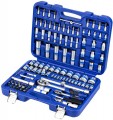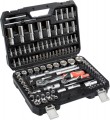Square drive size
The size of the "seat" for which the socket heads included in the package are designed (see below), in other words, the size of the square hole on the back of the head used for installation on a ratchet, wrench or other similar tool. Accordingly, the tool for working with heads supplied in the kit has the same dimensions of the landing square; and in the absence of such tools in the kit, data on the size of the heads will be useful for its selection.
There is a generally accepted standard for these sizes, providing for the designation in fractions of an inch — from 1/4 "to 1". Thanks to this, heads and tools from different sets can be quite compatible — just matching in size is enough. Most often in modern hand sets there are options in 1/4 "and 1/2", a little less often — 3/4" and 3/8". Some sets include several variants of the landing square at once.
Socket heads (6 points)
Number of
hex sockets included in the tool kit.
All end heads are accessories for a collapsible tool; during operation, they are mounted on a ratchet, wrench or other similar device. The head itself has the appearance of a characteristic “cap”, which, during operation, is put on a bolt, nut, etc. This design, among other things, allows you to work with parts located in recesses and some other hard-to-reach places that cannot be reached with open-ended, captive or split keys. And compared to a set of classic socket wrenches, the holder plus socket set takes up much less space, providing almost the same functionality.
As for the 6 faces, this type of socket head is the most famous and widespread, because. most modern nuts and bolts have this shape.
Socket heads sizes (6 points)
Working size range of hex sockets (see above) supplied with the kit. This parameter allows you to evaluate how the heads fit the dimensions of the fasteners with which they are planned to be used.
Socket heads (12 points)
Number of
dodecahedral sockets included in the tool kit.
All end heads are accessories for a collapsible tool; during operation, they are mounted on a ratchet, wrench or other similar device. The head itself has the appearance of a characteristic “cap”, which, during operation, is put on a bolt, nut, etc. This design, among other things, allows you to work with parts located in recesses and some other hard-to-reach places that cannot be reached with open-ended, captive or split keys. And compared to a set of classic socket wrenches, the holder plus socket set takes up much less space, providing almost the same functionality.
Specifically, the 12-sided type of socket heads is considered more versatile than the hexagonal one: it makes it possible to work with both classic hexagonal fasteners and, in fact, twelve-sided ones. In addition, to hook the next face, it is enough to rotate such a tool by only 30 ° when rearranging (whereas for 6-sided nozzles this figure is 60 °, and in cramped conditions there may not be room for this). On the other hand, 12-sided parts are quite rare, and when working with hexagonal parts, the contact area is small, which increases the risk of stripping edges and reduces torque.
Socket heads sizes (12 faces)
Working size range of dodecahedral sockets (see above) supplied with the kit. This parameter allows you to evaluate how the heads fit the dimensions of the fasteners with which they are planned to be used.
Socket heads sizes (E-profile)
Working size range of E-profile sockets (see above) supplied with the kit. This parameter allows you to evaluate how the heads fit the dimensions of the fasteners with which they are planned to be used.
Bit sizes
Varieties of bits (see above) included in the set.
Note that this paragraph specifies not just the size, but also the type of slot for which this or that bit is designed. This type is indicated by a letter index followed by a number describing the size — for example, SL5. Here are the most popular designations found in modern bits:
— SL. Flat bits for straight slot. The size is indicated in millimetres.
— Ph. Classic cross bits. The size is indicated by a conditional number.
— P.Z. Bits for a modified cross slot with improved engagement, have additional edges. The size is indicated by a conditional number.
— TX, T. Torx bits, with six-pointed sprocket tips. The size is indicated by a conditional number.
— H. Hex bits, with hex tips. The size is indicated in millimetres.
If there is more than one bit of a certain type in the set, the number is specified after the designation, for example, PH2x2.
Weight
The total weight of the tool kit. Indicated with a case, stand or other storage/transportation device (see Tool Storage). First of all, you should pay attention to this parameter if you plan to often carry the kit over long distances — the lighter the weight, the easier it will be to do. At the same time, extensive sets inevitably turn out to be weighty.

